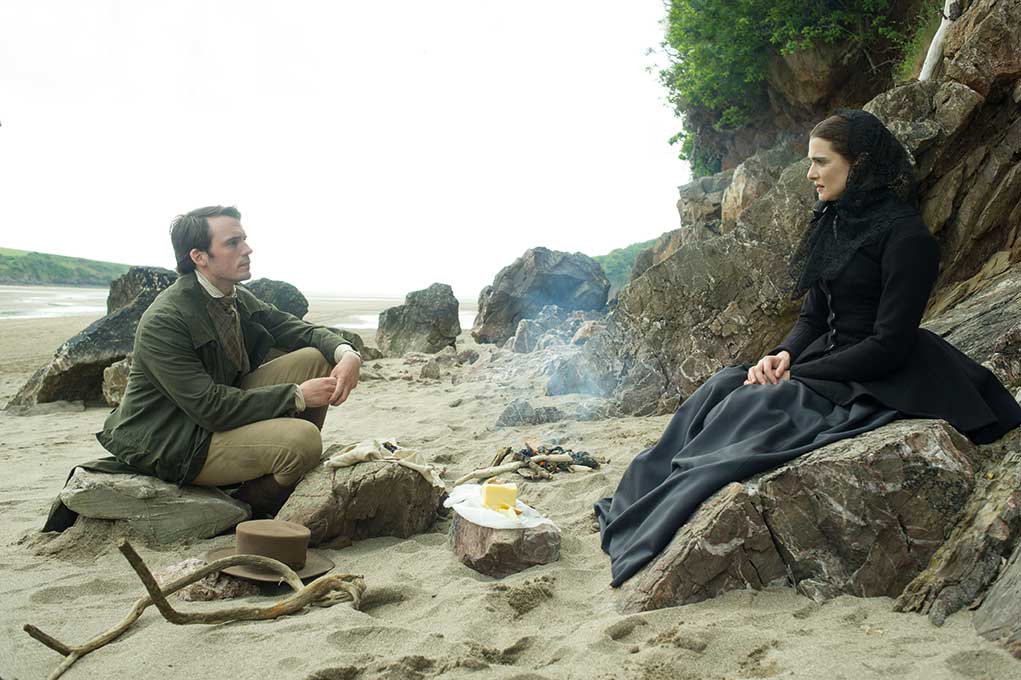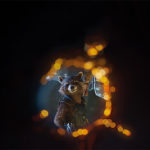
Wicked Game
Posted on Oct 5, 2017 by Julian Mitchell
 As well as the single or group of flames, Mike used a candlelight ‘zap’ light built by his gaffer as a natural light source.
As well as the single or group of flames, Mike used a candlelight ‘zap’ light built by his gaffer as a natural light source.
Daphne Du Maurier’s bitter 19th century tale of lost love, deception and greed meets 21st century digital cinematography: and it looks great
Cinema is in a strange place. The Cannes Film Festival in a protectionist move has from next year banned any film from entering that hasn’t had a theatrical release in France – they’ve basically banned Netflix. The battle lines are drawn. At the same time, you look at the hopefuls for the biggest cinema earners this summer and all you find are sequels and new franchise entries (apart from Dunkirk). Box office gamblers are already betting on at least a 10 percent lowering of cinema tickets being sold this year. Surely you should be making love not war with the streamers.
So thank god for reliable period dramas and especially ones that mix period with thrills. My Cousin Rachel isn’t one of Daphne Du Maurier’s better known books; far better known are The Birds and Rebecca. But the 1952 movie version of the novel starring Richard Burton garnered four Oscar nominations and a Golden Globe win for Burton.
In a way, pre-electricity romantic thrillers are perfect for digital cinematography, sensitive sensors to manage the light or lack of it in the dark rooms, digital grading techniques to deal with any inherent unwanted noise and new generation LEDs to either ape candlelight or bring out some highly directed and meaningful colour. But the 2017 production of Rachel had more tricks up its sleeve.
19th Century Man
 My Cousin Rachel plumbs the depths of deceit, love and greed with a look to match.
My Cousin Rachel plumbs the depths of deceit, love and greed with a look to match.
The film’s DOP, Mike Eley, feels in a cinematographic way as though he’s somewhat stuck in the 19th century with Jane Eyre, Parade’s End and Klondike mini-series done and another 1890 movie just finished. But this new version of My Cousin Rachel played to his particular skillset and it was no surprise that the movie was digital from the off.
“To be honest I feel I’ve spent a lot of my recent years in the 19th century in one way or another,” he says. “I did Jane Eyre on TV and Parade’s End which is more Edwardian than Victorian. I’ve done a lot of candlelight stuff, put it that way. So you have to be vigilant that you’re not going back and repeating yourself. As ever the script leads you; this, however, is quite an intimate story and not a cast of thousands – in fact it’s mainly a two-hander a lot of the time.
“It was a digital shoot and in fact it was always going to be. I’d previously worked with Roger (Michell, the director) on a couple of TV things and they were both on the ALEXA. Roger really loves that camera. We ended up shooting in 2016, although we thought we were going to shoot in 2015.” At the time Mike and Roger were very interested in using the ALEXA 65 camera; a visit to ARRI Rental in London got the team very excited by the camera and the lenses that they had at the time, even though they were pretty restricted to some Hasselblads and others. “We were thinking of portraiture really, there was something about the image that felt very heightened. Unfortunately, the economics of shooting on the ALEXA 65 didn’t make sense even though the production was pushed back a year.”
My Cousin Rachel is set in Cornwall, it is Du Maurier after all, but the coastal exteriors were shot in Devon. “Another reason we wanted the ALEXA 65 format was for those landscapes but we also wanted to use it quite intimately, because it’s an intimate story, a rather claustrophobic story. But that claustrophobia and making a virtue of the darkness inherent in those times, around 1840, made the standard ALEXA a good fit.”
The coastal aerials were drone shots done by Helicopter Film Services on the ARRI ALEXA Mini and gave the coastline a great cinematic quality. “It’s as if you had a massive crane once it’s up there, the composition is that good.”
With the delay in shooting, DOP and director had plenty of time to talk about how they wanted to shoot it. “Roger said we wanted to be respectful of the period but we didn’t want to be slavish to it. We didn’t want to be tied down by being a period piece. So we talked a lot about keeping it feeling quite contemporary as if we had just landed magically in that time and were able to record events. There was a lot of talk about hand-holding the camera and having the camera ‘alive’ but only when the story suggested it. We wanted to have the camera very reactive to the action and to be in amongst the actors. Rather than sitting back and being all elegant and sort of formal, be a bit more visceral about it. So in the end we got a good balance, really; there’s a nice free-wheeling aspect to it, so it’s sort of evolved in that way.”
 The production found a house in Surrey that was in urgent need of money for restoration – it was perfect for the movie.
The production found a house in Surrey that was in urgent need of money for restoration – it was perfect for the movie.
Rachel Weisz
 One of the best faces in movies, Rachel Weisz.
One of the best faces in movies, Rachel Weisz.
Roger Michell, the director, wanted his Rachel to be this enigma. At the beginning of the movie we half-glimpse her; she’s a character that we view through things, whether it’s candlelight or muslin. It’s as the character Philip would see her or imagine her. “That was the jumping-off point but I also saw the opportunity to be very obviously glamorous. There’s a point in the middle of the film where Philip has obviously fallen head over heels in love with Rachel and she emerges in to the room in an off-the-shoulder number with a necklace – she just looks stunning. I remember looking at some John Singer Sargent portraits of the well-to-do in the late 19th century; he painted these ladies of society with luminous, alabaster skin and dark backgrounds. I wanted to evoke that and have a really seductive look for Rachel and concentrate on her journey in Philip’s mind throughout the story. She goes from that to something quite different in the end. But here was a nice opportunity to deliver something very glamorous.”
Rachel Weisz is no doubt a powerful screen presence and Mike definitely had plans to bring her own luminosity to the digital screen. Shooting was mostly to be on location, and thanks to a cry for help from the new owner of an old house that needed urgent refurbishment, they found exactly what they wanted.
“We found a house as a location that was the centre of our story. A lot of these stories you have to stitch together various old houses around the UK but we were very fortunate to find a house in West Horsley – the 50-room West Horsley Place near Guildford. This played as our house, the rooms were all inter-connected which not only made it logistically clearer for us but meant we could physically move through rooms and go from one to the other.
“So I could plan and keep on top of lighting designs for those rooms but at the same time I wanted to keep it simple; I don’t like to be too fussy with lights. In that period, apart from candles and oil lamps, there was nothing, so I used candlelight quite a bit. In fact my gaffer created our own candle units so we could cluster some candles together in a concave design with a metallic back. It became like a candlelight ‘zap’ light that we could manoeuvre around just off camera to give us a boosted candlelight look, but you’d still get the flame flicker approach rather than having a China Ball there with an electrician on hand. I used small Tungsten sources for inside. All the night scenes are shot at 1600 ASA on the ALEXA, which gave us extra scope as far as the sensitivity was concerned. I really quite enjoyed the texture that the little bit of noise that comes with it gave us. Very often, we were able to operate without very much light and without giving the focus puller too many nightmarish situations – it’s always a fine balance.
“It was quite a simple lighting package, really, but I like to use practicals in association with the art department; it was good to get them to help in that regard. It was a chance to portray that world as it might have been – once the sun went down it was a dark place, which enhances the tone of the story. Even in the interiors during the day the light had to push its way in. With the ALEXA being so good at digging out detail in the shadows it was a chance to put the camera through its paces. Thinking about the grade, it was always nice to see how much was really there. Sometimes we gave the shadows a lift while other times we quite enjoyed it as it was; in some scenes all we used was one candle to light it. It had me worried as I know a lot of cinemas can have rather underpowered projection. It’s all fine being in a Soho grading suite, but elsewhere you might not have the same low-light performance. But I was enjoying the darkness of it all.”
Lenses
Being a historic tale the emphasis didn’t have to be on the sharpness of the resolution, so for lens choice Mike looked to vintage glass. “We had a set of TLS Speed Panchros which were our main lenses; we did have a couple of Angenieux zooms but I don’t think they were used very much. We also used some Zeiss Super Speeds, but not often. We had a few two-camera days but it was mostly a single camera shoot. Roger the director liked the focus of a single camera, as do I. The Speed Panchros were chosen after looking at a variety of options – they just seemed to have a really lovely look to them and all were quite different. They had a nice ‘roundedness’, as I would say.”
 Devon was substituted for Cornish coastal scenes
Devon was substituted for Cornish coastal scenes
Since period shows such as Downton Abbey and Upstairs, Downstairs started to use digital cinematography, DOPs have taken another look at their lighting designs. The change has been dramatic and arguably affected ‘the look’ more than any other piece of technology in high-end drama or cinema. Downton Abbey had the controlled, balloon-type lighting, The Crown had one big, soft source with actors on the edge of the darkness. My Cousin Rachel takes us back to the period with dramatic effect and one-candle scenes. As the credits roll you may still be in the dark. “There’s an ambiguity about the story; hopefully people will come out saying ‘did she or didn’t she?’”







